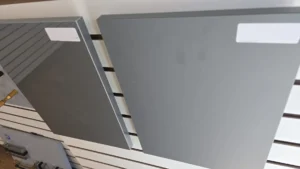Woodworking enthusiasts and professionals alike often face the dilemma of choosing the right materials for their projects. Two popular choices are Medium Density Fibreboard (MDF) and Plywood, both engineered wood products with distinct advantages and disadvantages. In this article, we’ll delve into the characteristics of MDF and Plywood, exploring their unique features, applications, and the considerations you need to keep in mind for your woodworking endeavors.
MDF (Medium Density Fibreboard):
MDF is an engineered material created by breaking down hardwood or softwood residuals into fine particles, combining them with wax and a resin binder, and subjecting the mixture to high temperature and pressure. This process results in a versatile material with various applications in woodworking.
Advantages of MDF:
- Cost-Effectiveness: MDF is generally more budget-friendly than plywood, making it an economical choice for projects with cost considerations.
- Smooth Surface for Painting: The exceptionally smooth surface of MDF makes it an ideal canvas for painting, providing a flawless finish for your projects.
- Consistency and Smooth Edges: MDF maintains consistency throughout, ensuring smooth cut edges without voids or splinters. This feature allows for easy creation of decorative edges using tools like routers.
- Ideal for Detailed Designs: The uniform texture and smoothness of MDF make it suitable for intricate designs, enabling easy cutting of detailed patterns with tools like scroll saws, band saws, or jigsaws.
Disadvantages of MDF:
- Susceptibility to Moisture: Similar to particle board, MDF tends to absorb water and liquids, leading to swelling. Proper sealing on all sides and edges is crucial to prevent this issue.
- Poor Screw Holding: Due to its fine particle composition, MDF does not hold screws as well as other materials, requiring careful consideration in project planning.
- Weight: The high density of MDF makes it heavy, posing challenges in terms of handling and maneuverability during woodworking.
- Unsuitable for Staining: MDF cannot be stained effectively due to its lack of wood grain. Attempts to stain may result in an undesirable appearance.
- VOC Emissions: MDF contains Volatile Organic Compounds (VOCs), such as urea-formaldehyde. Precautions should be taken during cutting and sanding to avoid inhaling harmful particles.
Plywood:
Plywood, another engineered wood product, is created by pressing and binding sheets of wood veneer together. It comes in different grades, each suited for specific applications, offering a range of choices for woodworkers.
Advantages of Plywood:
- Strength: Plywood, made from multiple layers of wood veneer, is a robust material, providing strength and durability for various woodworking projects.
- Water Resistance: Plywood is less susceptible to water damage compared to MDF, making it suitable for applications where moisture resistance is crucial.
- Stainability: With a natural wood grain, plywood is stainable, making it perfect for projects like kitchen cabinets and tabletops where a stained wood surface is desired.
- Secure Screw Holding: The varying grains of wood on each layer of plywood give screws a reliable grip, ensuring a secure hold in your projects.
In conclusion, the choice between MDF and plywood depends on the specific requirements of your woodworking project. Consider factors such as cost, application, and desired aesthetics to make an informed decision. Whether you opt for the smooth versatility of MDF or the strength and natural beauty of plywood, both materials offer unique benefits for your crafting endeavors.
Related blogs

An Analysis of the Advantages and Disadvantages of Different Edge Treatment Methods for Melamine Plywood
Melamine plywood, a material widely used in furniture manufacturing, interior decoration, and other fields, has

Additives Used in Plywood Glue: Functions and Benefits
Additives are essential in plywood glue formulations, enhancing the performance, durability, and environmental friendliness of

Synchro Plywood: A High-Quality Composite for Realistic Wood Finishes
What is Synchro Plywood? Synchro Plywood is an innovative composite material designed to emulate the

The 5 Best Kitchen Cabinet Materials: Pros and Cons
Choosing the right material for your kitchen cabinets is essential for both style and durability.
